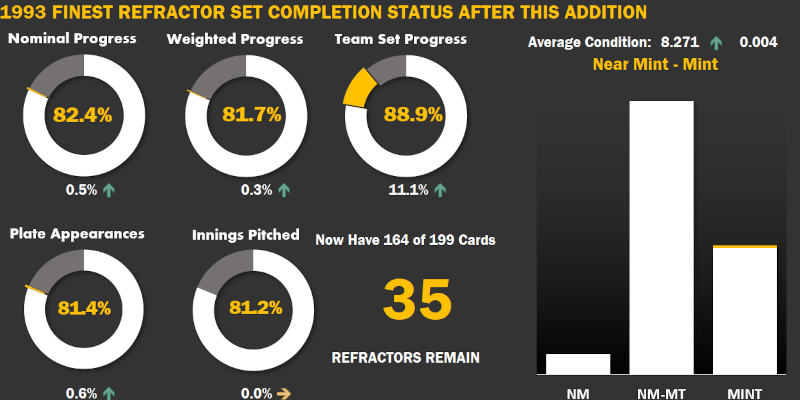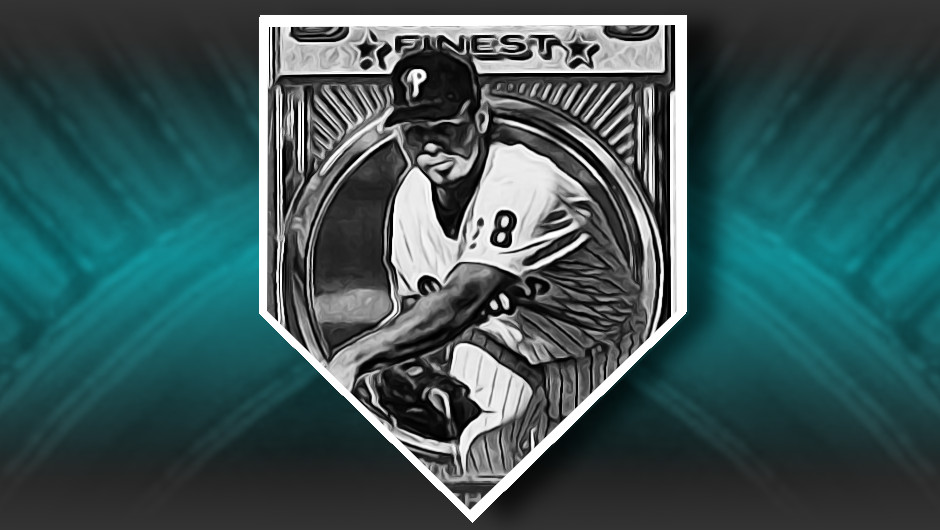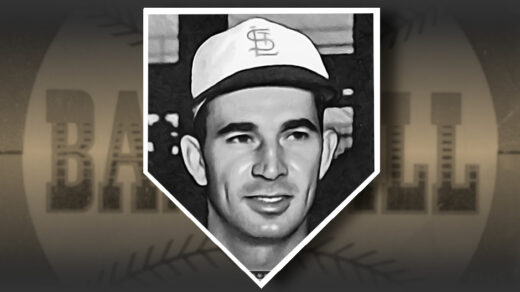Last year the baseball world was excited to witness the first 40/40 season since 2006. It was only the fifth instance of a player hitting at least 40 home runs while stealing 40 or more stolen bases. In 2023 Ronald Acuna, Jr. joined the likes of Barry Bonds and Alex Rodriguez in producing a rare single-season combination of speed and power. Not only did Acuna add his name to a list that also includes Alfonso Soriano and Jose Canseco, he did it with an absolute surplus of baserunning overkill. Previously, no player in the 40/40 Club had eclipsed the 40-mark for HRs or SBs by more than 6. Acuna sped past that, swiping his 40th base before the All-Star Break and ending the year with 73. It may have been the best 40/40 season we have ever seen.
And yet, there is a better 40/40 that is invisible from the statistics showing up on the back of baseball cards. This mythical season saw a player approach a 50/100 HR/SB line before an overconfident Oakland Athletics outfielder even proposed going for the 40/40 mark.
Eric Davis, a Cincinatti Reds outfielder, officially tallied a 20/20 season in 1986 (27 HR / 80 SB) that was much more special than the year-end stat line would suggest. From June 18 of that year through the next 162 games he hit 49 home runs and stole 93 bases. That’s a hidden 50/50 season in a period that only previously known 30/30 campaigns. He had 99 steals in the 162-game period that began 10 days earlier. If a 50/90 season wasn’t good enough, a 50/100 season may have been a possibility. This wasn’t just “Eric the Red” running on every pitch just to see what stuck. He was legitimately one of the greatest base thieves of all time. His career stolen base success rate was 84.1%, good for 17th place all-time today and second only to Tim Raines at the time of his retirement among players with 200+ attempts. Imagine a combination of Barry Bonds and Rickey Henderson and you get an idea of how special Eric Davis was.
Of course, the stats on baseball cards only show what actually happened in time periods split into revolutions around the sun. A big chunk of that 50/50 season that wasn’t came in what would be officially recorded as the 1987 season. That year, Davis had already joined the 30/30 club by the first week of August. He injured his ribs after running into the outfield wall in early September and subsequently missed 10% of the season, returning in time to play 10 very sore games in which he could not swing hard. He finished the year with 37 HRs and 50 SBs, almost a 40/40 season in itself. Those missed games would have likely yielded another 3-4 HRs and a lack of soreness in the remaining contests could have produced another couple dingers. So close.
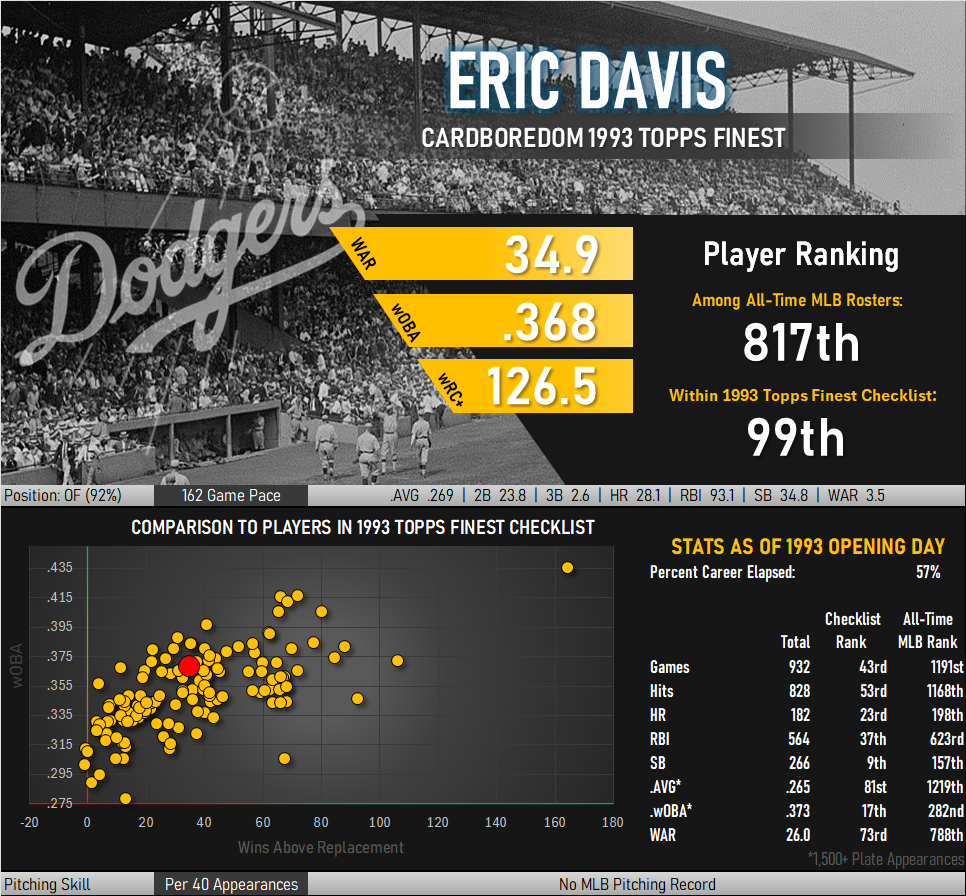
Eric The Red’s Dodgers Cards Could Have Been Epic
Injuries were stacking up against Davis by the time the 1990s arrived. This included an outfield dive so hard that it tore one of his kidneys in the 1990 World Series. The Reds saw this as more or less the end of his career as an effective player and traded him in a package deal to the Dodgers for John Wetteland and Kip Gross.
This in turn made the Dodgers look like instant contenders as they had recently acquired repeated 30/30 outfielder Darryl Strawberry. The team still had Brett Butler and Kal Daniels battling for the third outfield spot, guys who would be starters on just about any other team. Upper Deck commemorated the combination of Davis and Strawberry with a multiplayer card in its 1993 release, highlighting the fact that both had grown up together in Compton and played for the same Little League team.
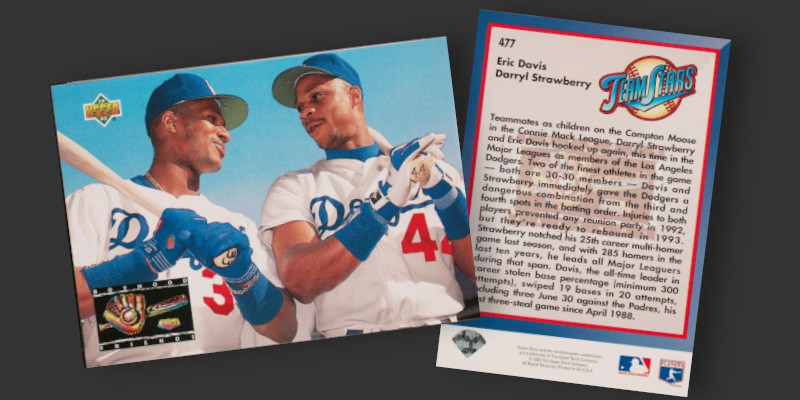
On paper the combination of hometown favorites Davis and Strawberry looked great. In practice, however, things were different. Strawberry’s career imploded from a myriad of off-field transgressions. Davis saw recurring injuries nag at his ability to play like he used to. 1993 would be the only season in his remaining time on the diamond in which he would surpass 130 games played (total played: 131). His batting average was just .232 in his two-year sojourn with the Dodgers. The team sent him to the briefest of stints with the Detroit Tigers at the trade deadline leaving a lot of fans in LA wondering what could have been.
Davis’s next decade saw him sustain multiple neck injuries and a cancer diagnosis and surgery that took him out of the lineup for a sustained period. He finished his career with 282 home runs and 349 stolen bases, respectful totals that look more impressive when presented on a per game basis.
The Reds jettisoned him from their lineup when they thought his career was over. Here’s the interesting part: Eric Davis wasn’t entirely washed up. Despite a constantly hurt neck, repeatedly hurt ribs and legs, and all the complications that come with colon cancer, he had the same batting average as when he was with the pre-1992 Reds (.269). His strikeouts still came at exactly the same rate (22.7%). Stolen bases dropped by half to a little more than 20 per 162 games and his success rate fell from 87% to 77%, but that is to be expected with playing to age 39. Davis’ post-1992 success rate is still better than the career success rates of Willie Mays, Otis Nixon, and even Bobby Witt, Jr.
Davis was fun to watch. When he was playing.
This ’93 Finest Is a Well Designed Card
There are some cards in the 1993 Finest set where Topps seems to have used whatever photo was available. Others, like this Eric Davis card, seem tailor made for the set. Davis’ white and blue Dodgers home uniform works well with the metallic silver of the card design. The red nameplate pairs perfectly with his number 33 framed by the motion of his swing. Sure, he’s looking down at what must be a ground ball, but he possessed the speed to turn an infield grounder into a base hit. The back features a batting cage shot, but from the unusual setting of portraying a player as a batting cage spectator.
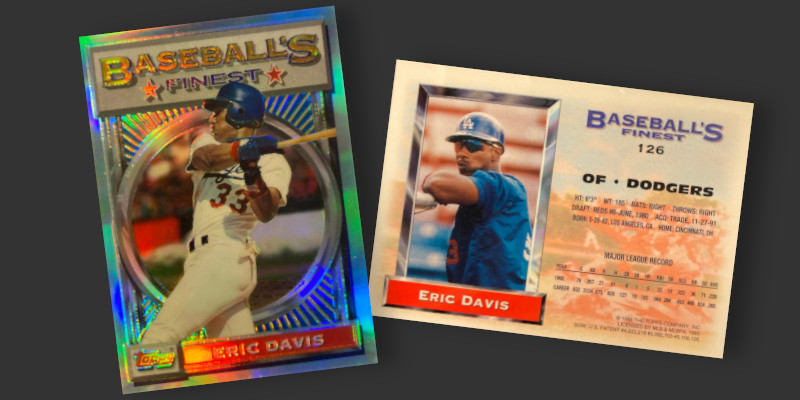
This card took a while to finally join my set building project. I always seemed to be the underbidder in online auctions. In other situations where the price was right I was always simultaneously having to weigh the acquisition of this card against some other shiny pick-up. No more.
